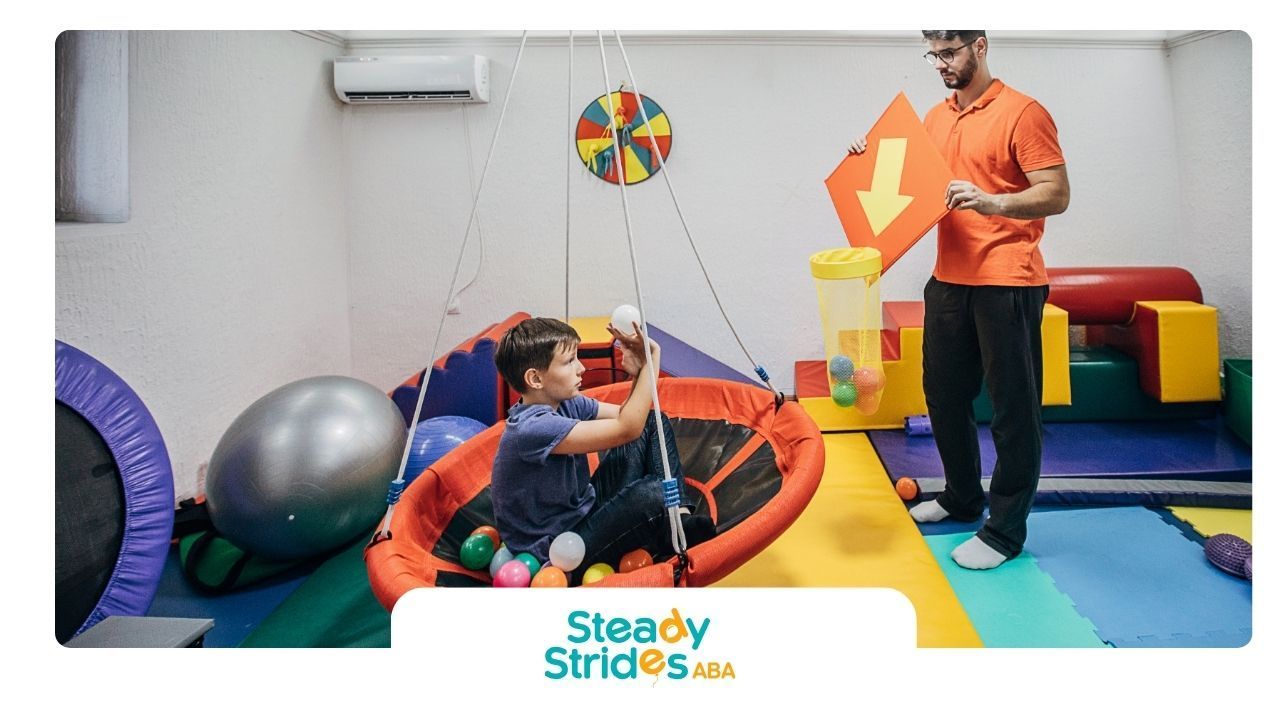Have you ever wondered how someone can learn to better understand their own actions and feelings? Applied Behavior Analysis (ABA) therapy is a powerful approach that helps individuals, especially those on the autism spectrum, develop vital skills in self-monitoring and awareness. This therapy provides a structured path to not only recognize behaviors but also to understand the emotions behind them. By fostering emotional awareness, ABA empowers individuals to navigate their world with greater confidence and independence.
Foundations of ABA Therapy and Self-Reflection
Applied Behavior Analysis (ABA) therapy lays the groundwork for understanding behavior by looking at its context. At its heart is a simple model that helps connect the dots between a situation, the behavior that follows, and its outcome. This foundational concept plays a crucial role in helping individuals see why they react the way they do.
This connection between actions and consequences is key to improving emotional well-being. By understanding their own emotional responses, individuals can begin to manage them more effectively. The role of ABA is to provide the tools and strategies needed for this journey of self-discovery. Let's explore the core principles that make this possible.
Key principles of Applied Behavior Analysis (ABA) for awareness
One of the central tenets of Applied Behavior Analysis is the ABC model: Antecedent, Behavior, and Consequence. The antecedent is what happens right before the behavior, the behavior is the action itself, and the consequence is what follows. Behavior analysis using this model allows therapists and individuals to understand the triggers and results of actions, which is the first step toward change.
To encourage positive behaviors, ABA often uses positive reinforcement. This means rewarding a desired action to make it more likely to happen again. Another key strategy is prompting, where gentle guidance is provided to help an individual perform a task, with the prompts gradually reduced to foster independence. These methods help build emotional awareness by making the connection between actions and outcomes clear.
By understanding these connections, individuals can better interpret social cues and manage their responses. This systematic approach not only improves specific skills but also enhances the overall quality of life by building confidence and self-understanding.
Why self-reflection matters in ABA practices
Self-reflection is a cornerstone of personal growth, and ABA therapy actively cultivates this skill. It goes beyond simply modifying behavior by encouraging individuals to become active participants in their own development. Techniques like self-monitoring, where a person tracks their own behaviors, build a strong sense of accountability and awareness.
When you learn to observe your own actions, you begin to understand yourself on a deeper level. ABA therapy strengthens a child's sense of self by teaching them to set goals, evaluate their progress, and even reward themselves for achievements. This process turns therapy into a journey of empowerment.
These are not just therapy exercises; they are essential skills for life. Developing the ability to self-reflect helps individuals gain independence, make better choices, and build the confidence needed to tackle everyday challenges. It is a fundamental part of building crucial life skills.
How ABA Therapy Develops Self-Reflection Skills in Children
ABA therapy helps children develop self-reflection by teaching them how to observe and track their own behaviors. This process of self-monitoring plays a vital role in building awareness. Instead of being passive recipients of instruction, children learn to become detectives of their own actions and feelings.
Because every child is different, ABA programs are customized to meet individual needs, building on their unique strengths. This personalized approach makes learning more engaging and effective. Let's look at some specific strategies used to teach self-monitoring and foster personal insight.
Teaching self-monitoring and recognizing behavior patterns
Self-monitoring is a key component of ABA therapy that empowers individuals to take charge of their own progress. It involves teaching someone to observe and record their own actions, which fosters a greater sense of accountability. Through this process, individuals can start to recognize behavior patterns they might not have noticed before.
This systematic approach to behavior analysis involves several key steps that build on one another. These interventions are designed to make the process clear and achievable.
Common self-management techniques include:
- Goal Setting: Defining specific, achievable targets for behavior.
- Self-Monitoring: Using tools like checklists or charts to track when a behavior occurs.
- Self-Evaluation: Reflecting on progress toward the set goals.
The data collection involved in self-monitoring provides valuable feedback for both the individual and the therapist. It helps identify what's working and where adjustments are needed, promoting better emotional regulation and paving the way for lasting change.
Strategies to foster self-evaluation and personal insight
Fostering self-evaluation is about more than just tracking behaviors; it's about helping individuals reflect on their actions and understand the outcomes. ABA strategies use a structured approach to guide this process, encouraging personal growth and deeper insight into one's own emotional states.
These strategies empower individuals to assess their actions against the goals they helped set. This promotes a greater understanding of cause and effect. Some effective ABA strategies include:
- Role-Playing Scenarios: Practicing social situations to evaluate different responses.
- Guided Discussions: Talking through events to explore feelings and choices.
- Self-Reinforcement: Learning to reward oneself for meeting goals, which boosts motivation.
Through these reinforcement strategies, individuals learn to connect their efforts with positive results. This structured method helps build the confidence to manage behaviors effectively, leading to increased self-awareness and independence in various settings.
Building Emotional Self-Awareness in Autism through ABA
For individuals with Autism Spectrum Disorder (ASD), understanding and expressing emotions can be challenging. ABA therapy directly addresses this by teaching the emotional skills needed to build emotional self-awareness. The impact of ABA can be transformative, as it provides clear, systematic ways to identify and label feelings.
This process helps demystify emotions, making them more manageable. By breaking down complex social-emotional concepts into smaller steps, ABA empowers individuals to better understand their inner world and the feelings of others. Below, we’ll explore specific techniques for emotional labeling and regulation.
Techniques for emotional labeling and identification
Yes, ABA therapy can absolutely improve emotional self-awareness, and it does so using several effective ABA techniques. One of the most common methods is using visual supports. Tools like feelings charts, mood meters, or emotion cards help children put a name to what they're feeling. These visuals serve as a concrete reference, making abstract concepts like "happy" or "frustrated" easier to grasp.
Another powerful tool is social stories. These are short, simple narratives that describe a social situation and highlight the emotional responses of the people involved. By reading or listening to these stories, children can learn to recognize emotions in others and themselves within a specific context.
Modeling by therapists and caregivers is also crucial. By demonstrating appropriate emotional expressions and talking about their own feelings, adults provide a clear example for children to follow. This combination of visual aids, stories, and modeling fosters emotional awareness in a supportive, structured way.
Strengthening emotional regulation using ABA methods
Once an individual can identify their emotions, the next step is learning how to manage them. ABA therapy improves emotional regulation by teaching specific, practical coping skills. Instead of feeling overwhelmed by strong emotions, children learn constructive ways to respond, such as taking deep breaths, squeezing a stress ball, or asking for a short break.
These new skills are taught through practice and positive reinforcement. For instance, a therapist might role-play a frustrating situation and guide the child to use a calming strategy. When the child successfully uses the skill, they receive praise or another reward. This reinforces the desired behavior change, making it more likely they will use the skill again in their daily life.
By consistently practicing these techniques, individuals build a toolbox of strategies for handling difficult emotions. This proactive approach helps reduce challenging behaviors that often stem from emotional dysregulation, leading to greater stability and confidence.
Promoting Mindfulness and Awareness Within ABA Sessions
Mindfulness, or the practice of focusing on the present moment, plays a pivotal role in modern ABA therapy. It enhances self-awareness by teaching individuals to notice their thoughts and feelings without judgment. Integrating simple mindfulness exercises, like deep breathing, can create a calm and supportive environment during sessions.
This practice helps individuals connect with their internal state, which is a key part of self-reflection. By learning to pause and check in with themselves, children and adults can better manage their emotional responses. Let's look at how these activities are woven into ABA therapy.
How mindfulness activities integrate with ABA therapy
Mindfulness activities integrate seamlessly with ABA techniques to promote self-awareness and emotional control. For example, therapists can incorporate "mindful minutes" into daily routines, guiding a child through a simple deep breathing exercise before transitioning to a new activity. This helps the child calm their body and focus their mind.
These practices are especially useful in different social contexts. A therapist might teach a child to take three deep breaths when they feel overwhelmed in a group setting. This simple action interrupts a reactive emotional spiral and encourages a more thoughtful response, promoting positive behaviors.
By making mindfulness a regular part of ABA sessions, it becomes a natural coping skill. The goal isn't to stop thoughts or feelings but to notice them. This relationship between mindfulness and ABA helps individuals develop a greater capacity to pause, reflect, and choose their response.
Encouraging present-moment focus for lasting awareness
Encouraging present-moment focus is a powerful way to build lasting awareness. ABA strategies help create a supportive environment where individuals can practice this skill without pressure. For example, a therapist might use a sensory activity, like focusing on the feeling of sand running through fingers, to gently guide a child's attention to the here and now.
This practice helps children develop self-reflection skills by teaching them to tune into their immediate experience. When you are focused on the present, you are more aware of your body, your breathing, and your emotional state. This awareness is the foundation of emotional regulation.
Over time, these exercises build essential emotional skills. A child who learns to focus on their breath when they feel anxious is developing a lifelong tool for managing stress. By embedding these moments of present-moment focus into therapy, ABA helps build a foundation for sustained self-awareness.
Role of ABA Therapists in Supporting Self-Reflection and Personal Growth
ABA therapists play a pivotal role in guiding individuals toward self-reflection and personal growth. They do more than just teach skills; they create a supportive environment where it is safe to explore feelings and behaviors. A key part of the role of ABA therapists is to model reflective thinking themselves.
By acting as a guide and collaborator, the therapist empowers the individual to take an active part in their own journey. This partnership is essential for building trust and achieving meaningful progress. The following sections will explain how therapists model these practices and work with families on goal setting.
Modeling reflective practices for children and professionals
One of the most effective ways ABA therapists support self-reflection is by modeling it themselves. During sessions, a therapist might say something like, "I noticed I was talking a little too fast. I'm going to take a breath and slow down." This shows the child that self-awareness and self-correction are normal, healthy processes.
This kind of reflective practice is also a core part of professional ABA training. Therapists are encouraged to constantly evaluate their own methods, reflect on session outcomes, and seek feedback to improve their practice. This commitment to their own personal growth makes them better equipped to guide their clients.
By demonstrating vulnerability and a willingness to learn, therapists create a powerful example. This modeling helps children understand that self-reflection isn't about judgment but about improvement, contributing to their confidence and overall quality of life.
Collaborative goal setting for improved self-awareness
Collaborative goal setting is a fundamental part of ABA programs that fosters ownership and motivation. Instead of goals being dictated by the therapist, they are developed in partnership with the individual and their family. This process ensures that the targets are meaningful and relevant to the person's life, which is crucial for personal growth.
When individuals help set their own goals, they are more invested in the outcome. This approach to behavior change connects the process of self-monitoring directly to a desired result, increasing emotional awareness along the way. For example, a goal might be to ask a friend to play during recess.
The process links a target behavior to a clear plan. Achieving behavior change through self-monitoring in this way helps individuals see their progress, which builds confidence and self-esteem.
| Area of Focus | Description of Goal | How to Monitor |
|---|---|---|
| Social Skills | Initiate a conversation with a peer once a day. | Use a checklist to mark each successful attempt. |
| Emotional Regulation | Use deep breathing when feeling frustrated. | Note instances of using the skill on a feelings chart. |
| Independence | Complete the morning routine without reminders. | Track progress on a visual schedule. |
Common Self-Reflection Activities Used in ABA Therapy
ABA therapy uses many creative and practical self-reflection activities to build awareness. These aren't just abstract exercises; they are tools that can be integrated into daily living. For example, using visual schedules helps individuals anticipate their day and reflect on completed tasks, giving them a sense of accomplishment.
These activities are designed to make the development of emotional skills feel manageable and even fun. They provide a structured way for individuals to check in with themselves and practice new abilities. Let’s explore some specific examples of these helpful exercises and strategies.
Examples of exercises and strategies that build self-awareness
ABA techniques include a variety of hands-on exercises designed to build self-awareness in a concrete way. These strategies often use visual aids to make abstract concepts easier to understand and are tailored to improve communication skills alongside self-reflection.
Many of these activities can be practiced in different settings, from the therapy room to home or school. Here are a few examples of common exercises:
- Feelings Charts: Using charts with faces showing different emotions to help individuals identify and label their feelings.
- Role-Playing: Acting out social scenarios to practice appropriate responses and reflect on outcomes.
- Video Modeling: Watching videos of oneself or others successfully navigating a situation to analyze and learn from it.
- Journaling: Drawing or writing about the day's events and emotions to promote reflection.
- Goal Setting Worksheets: Using worksheets to break down a larger goal into small, manageable steps and track progress.
These structured activities provide repeated opportunities to practice self-awareness. They empower individuals by giving them tangible tools to understand themselves and interact more effectively with the world around them.
Conclusion
In summary, ABA therapy serves as a powerful tool for encouraging self-reflection and awareness in children, especially those on the autism spectrum. By integrating techniques that promote emotional regulation, mindfulness, and personal insight, this therapeutic approach not only enhances behavioral understanding but also fosters deeper emotional connections. The role of ABA therapists is crucial in modeling reflective practices and collaborating with families to set meaningful goals. As we cultivate these skills, we empower children to become more aware of their behaviors and emotions, ultimately guiding them toward personal growth and a brighter future. If you're interested in exploring how ABA therapy can benefit your child, don't hesitate to reach out for a free consultation.
At Steady Strides ABA, we believe that true growth begins with self-understanding. Serving families throughout Texas and New Mexico, our team uses ABA therapy to help children develop self-reflection, emotional awareness, and a deeper sense of who they are. Through personalized, supportive sessions, we guide children in recognizing their thoughts, feelings, and actions—empowering them to make positive choices and express themselves with confidence. At Steady Strides ABA, every step forward is more than progress—it's a stride toward self-discovery and lasting independence.
FAQs
Can ABA therapy improve emotional self-awareness in children with autism?
Yes, ABA therapy is highly effective at improving emotional self-awareness in children with autism spectrum disorder. It uses structured techniques like visual aids and modeling to teach emotional identification and emotional regulation. This approach leads to positive outcomes by helping children better understand and manage their feelings.
What role does self-monitoring play in ABA therapy?
Self-monitoring plays a crucial role in ABA strategies. It is a structured approach where individuals learn to observe and track their own specific behaviors. This process increases their awareness, promotes accountability, and is a fundamental step toward achieving lasting behavior change and gaining more independence.
How do ABA therapists support self-reflection for professional development?
ABA therapists support their own self-reflection through ongoing ABA training, supervision, and engaging in reflective practices about their sessions. This commitment to personal growth helps them create a more effective and supportive environment, allowing them to better model these important skills for their clients during daily routines.
Sources:
- https://www.autismspeaks.org/applied-behavior-analysis
- https://www.autismspeaks.org/what-autism
- https://www.bcm.edu/research/faculty-labs/luna-learning-to-understand-and-navigate-anxiety/caregiver-modules/module-10-parenting-strategies-for-managing-challenging-behavior/how-behaviors-are-learned-the-abc-model













